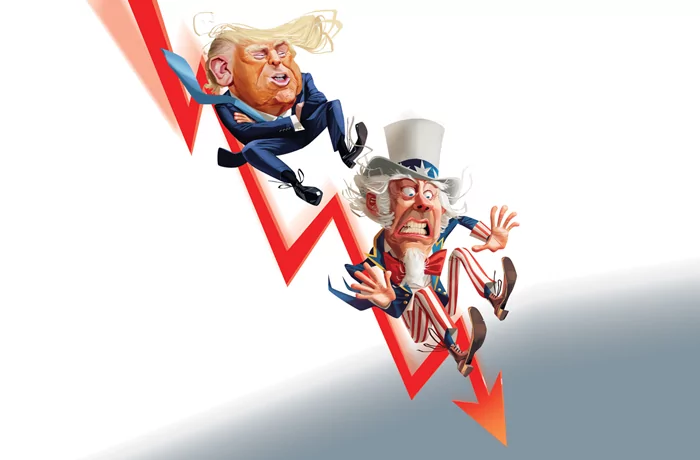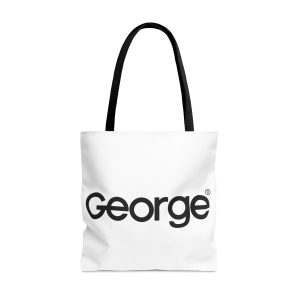
President Donald Trump capped a tumultuous week in Washington and Wall Street by suspending most of his aggressive tariffs regime for 90 days, acknowledging investors and the general public “were getting a little bit yippy, a little bit afraid.”
Trump acted after one of the biggest drops in the stock market since the pandemic. Interest rates on 10-year Treasury bonds were also rising, raising the prospect of an ugly and expensive economic situation. The White House said that at least 75 countries had offered to negotiate new trade deals with the United States since the tariffs were announced, with talks slated to occur during the 90-day hiatus.
On April 7 alone, the S&P 500 closed down 0.2% as the Dow Jones Industrial Average fell 0.9%, or by 350 points. The Nasdaq did manage to end the day up 0.1%, thanks to the chipmaker Nvidia. Recession fears rose, and Trump’s poll numbers on the economy fell. After the tariffs were put on hold, the markets began to recover.
Trump hasn’t relented entirely. Only the “reciprocal” tariffs on most countries will be paused. Both the 10% minimum and steep new tariffs on China will remain in effect, barring another unexpected White House turnaround.
The Trump tariffs were not entirely a surprise. He had openly campaigned on them last year, citing President William McKinley and saying “tariff” was a “beautiful word.” During his first term, Trump imposed tariffs on China that former President Joe Biden largely left in place. Trump also negotiated NAFTA, the North American Free Trade Agreement, which he repeatedly derided as a “stupid deal.”
More importantly, Trump has been an economic nationalist complaining about foreign companies and governments ripping off American consumers and businesses since at least the 1980s. When Trump won the 2016 Republican presidential nomination, it was considered a major rebuke to the party’s decadeslong consensus in favor of free trade.

But Trump’s first-term tariffs were more limited than the ones he imposed in a Rose Garden ceremony he hailed as “Liberation Day.” His first four years in office were marked by low inflation in addition to low unemployment and a growing economy, until the pandemic struck and most of the country adopted lockdown measures to mitigate the spread of the virus.
While Trump was out of office, inflation exploded to a 41-year high under Biden in 2022. Although it came back down, it remained above the Federal Reserve’s preferred rate for the rest of his presidency and into Trump’s second term. More importantly, consumers continued to feel the pain of a cumulative 20% price increase on many necessities even as the annual rate of inflation slowly cooled down.
Trump was elected in large part because of widespread voter dissatisfaction with inflation and the high cost of living. A famous and wealthy businessman before entering politics, he had long been trusted as someone equipped to handle the economy. During his four-year hiatus from the White House, voters mostly forgave Trump for the COVID-19 lockdowns, which he had adopted reluctantly and came to resist as the year wore on. Polls suggested they instead associated Trump more with the economic conditions of 2019, which they wanted to see restored. The annual inflation rate was 1.81% back then, and it fell further to 1.23% in 2020, which was Trump’s last full year in office.
All this made it reasonable for voters to expect that fighting inflation would be a bigger Trump administration priority than reordering global trade. Yet Trump is constitutionally ineligible to seek another term in 2028, and Republicans could lose the House as early as the midterm elections next year.
So Trump went big. “Sometimes you have to take medicine to fix something,” he said. As is often the case when a newly elected president does things that are bigger than the limited mandate they received at the ballot box, investors and many voters didn’t approve. “This is not what we voted for,” billionaire Bill Ackman, who emerged as a big Trump supporter last year, wrote on social media.
Many didn’t like the fact of the tariffs. The global economy is much more integrated than when McKinley was president. Tariffs on steel, for example, could raise prices for U.S.-based steel-using businesses. Others didn’t like the uncertainty about when they would go into effect, on which countries, and at which rates, which seemed at times to be in a state of flux.
There were also competing explanations for why the tariffs were being imposed in the first place. Trump clearly wants to reshore some American jobs, reduce trade deficits, and disentangle the U.S. economy from China, though some of this will necessarily be a long-term project. He and his advisers believe that many, perhaps most, foreign countries are more dependent on access to the U.S. market than the other way around.
But was the goal to raise enough revenue from tariffs to replace the income tax? To persuade other countries to lower their trade barriers to American businesses and products? To isolate China more quickly? While the tariffs could presumably do multiple things at different points in time, it is difficult to see how all these objectives could be reconciled at once.
Many observers were confused when the “reciprocal” tariffs appeared to be tied to trade deficits with various countries rather than the tariff rates they imposed on the U.S. While some defended this practice as essential to the purpose of achieving more balanced trade, it wasn’t what many in the business world anticipated when the tariffs were introduced.
The Trump tariffs have created the biggest fissures with political and business community leaders who are otherwise strongly supportive of the president, more significant than disagreements over Ukraine or the Department of Government Efficiency. Republicans on Capitol Hill, who have come to appreciate Trump more as a political survivor compared to the first term, are still mostly skeptical of his views on trade. Sen. Ted Cruz (R-TX), a frequent Trump supporter, told Fox Business, “I am not a fan of tariffs. … If the result is our trading partners jack up their tariffs and we have high tariffs everywhere, I think that is a bad outcome for America. Tariffs are a tax on consumers, and I am not a fan of jacking up taxes on American consumers.”
While Cruz was open-minded about whether that would be the actual outcome of Trump’s trade policies or whether they would instead lead to lower tariffs on the U.S., that is a far cry from celebrating tariffs as a beautiful word.
Many congressional Republicans are also reluctant to embrace the idea that one man should have the power to reorder the global economy, though so far, only a handful have announced their support for legislation that would take back lawmakers’ tariff-making authority. When even more humble presidents have talked about the “New World Order” or the “New Paradigm” in the past, the reaction has often been negative.
Commentator Shay Boloor penned an open letter to Trump on X, expressing sympathy with “the idea of a harder, smarter America-first policy that pushed for fair treatment, reciprocal agreements, and a real industrial strategy rooted in technological superiority, national security, and capital formation.”
“But that’s not what this is,” he continued. “What you’ve rolled out isn’t detox — it’s whiplash. This isn’t strategic decoupling. It’s scattershot retaliation dressed up as reform. There’s no roadmap. No operational playbook. No clear articulation of where this ends or what the metrics of success even are.”
The tariffs have also brought us a big display of public infighting within the Trump administration, something that was common in the first term but has been relatively rare this time around. So, when Elon Musk openly spars with top Trump trade adviser Peter Navarro, with them questioning each other’s competence and intelligence, it is noteworthy.
Navarro is a trade hard-liner and one of the leading public proponents of the idea that the tariffs are no mere negotiating tactic. Others, such as Treasury Secretary Scott Bessent and Commerce Secretary Howard Lutnick, have been more measured on that front. “They are negotiable but not a negotiating tactic” was one memorable Bessent quote.
The increasingly libertarian Musk, on the other hand, has become a rare Trumpworld voice for free trade. He has said he hopes the end result is zero tariffs between the U.S. and the major countries of Europe. In addition to ideological and policy differences, Musk has global business interests (a reason some populist nationalists, such as former Trump White House chief strategist Steve Bannon, have never trusted him). And Musk also has to wonder how the controversy over tariffs will affect his own lightning portfolio.
Trump is more deeply invested in trade policy and deal-making than he has ever been in streamlining the federal bureaucracy. If tariffs get too hot, might Trump become less interested in spending political capital on Musk’s DOGE? “Boys will be boys,” a grinning White House press secretary Karoline Leavitt replied when she was asked about the Musk-Navarro feud.
Either way, Trump has pivoted once again. The 10% tariffs still give countries some incentive to negotiate. And while it may create additional uncertainty, Trump argued that it was important to adapt to changing circumstances.
“You have to have flexibility,” he told reporters after the pause. “I could say, here’s a wall, and I’m going to go through that wall, and I’m going to go through it no matter what. And you keep going and you can’t go through the wall. Sometimes, you have to be able to go under the wall, or around the wall, or over the wall. … I think the word would be flexible. You have to be flexible.”
Some celebrated the shift. “Today’s moves, doubling down on the 10% global tariff and temporarily suspending reciprocal tariffs as promising negotiations proceed, have greatly strengthened the foundation of the president’s vital push to address the failures of the international economy,” American Compass’s Oren Cass said in a statement. “In the months to come, those negotiations should focus on the national priorities identified by the administration for a U.S.-led economic and security alliance that promotes balanced trade, allocates defense burdens, and excludes China.”
The pause hasn’t solved every problem, however. While the markets initially rallied, stocks fell again the following day, erasing nearly half of the previous gains. By midday on April 10, the Dow Jones Industrial Average had dropped 1,687 points, or 34.1%. The S&P 500 fell 4.8%, while the Nasdaq Composite shed 5.5%. Americans’ 401(k)s were not yet safe.
TRUMP BETS HIS PRESIDENCY ON TARIFFS
Trump is undeterred, dismissing the notion he has or should capitulate. “It’s the only chance our country will have to reset the table,” he said at the White House during a visit by Israeli Prime Minister Benjamin Netanyahu. “I could have come in and had an easy term. But no other president would be willing to do what I am doing or even go through it. I don’t mind because I see the end goal.”
Voters who hoped Trump would have an easy term when they decided to reward him with a historic political comeback will now have to strain to see it for themselves.
W. James Antle III is executive editor of the Washington Examiner magazine.



